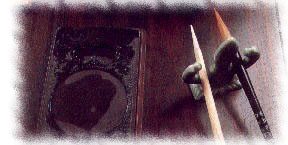Learning & Literature -- the Four Treasures of the Study
Traditionally
The "four treasures of the study" are a brush pen, an inkstick, paper, and an inkstone because they are indispensable to any traditional Chinese scholar. Only through, these four tools can the Chinese painter or calligrapher create the beauty of Chinese art. As a result, much importance has been attached to the "four treasures of the study."
The Brush

|
The brush pens are classified by the type of hair used: goat hair, wolf hair, and purple hair. Wolf hair brushes are actually made from weasel hair and purple hair brushes from rabbit hair. Goat hair brushes are soft, flexible, and absorbent. Purple hair brushes produce bold lines and are best suited to calligraphy. Sometimes, to achieve a balance between steely and feathery lines, a brush that combines hair from two different types of animals is used. Not only is the handle made from bamboo, wood, lacquer, and porcelain, but also from precious materials including mother-of-pearl inlay, ivory, and jade. Usually, painters and calligraphers have several types of brushes on hand to adapt to individual purposes and preferences.
The Inkstick
The ink-stick is the pigment of Chinese traditional painting and calligraphy. Initially, natural ink or half-natural ink was generally used. Eventually, artificial ink appeared. The Inkstick is made from a mixture of soot and resin, molded into stick form. The three types of soot most commonly used pine, oil, and lacquer soot. A good inkstick is finely grained and has an even and smooth texture. It is firm and not sticky. It is pure, solid black in color, without murkiness or roughness.
Paper
Paper was invented by a Chinese named Cai Lun around 105 A.D. Slowly, paper supplanted traditional bamboo slips and silk. Seven hundred years later, papermaking technology was absorbed by Islamic countries. Around the 13th century, paper began replacing papyrus and parchment in Europe.
The Inkstone

|
Modernization
While retaining the strengths of the traditional "four treasures of the study," modern technology and materials are being applied to make these treasures even more practical and suited to the needs of the user. The dependence of the Chinese arts of calligraphy and painting on this set of "treasures of the study" to express the ideas, writing system, experience, and feelings of the Chinese people has brought forth an eternal cultural institution. As a result, Chinese calligraphy and painting has sparked much interest and discussion in the international art world.
For instance, recent research and development has created the possibility of manufacturing a fine quality of paper from pineapple leaf fiber pulp. Because it is soft and flexible, this type of handmade paper has an almost perfect degree of absorbency for brush-and-ink calligraphy and painting, so the art and the material combine to produce optimal results.



 Chinese Culture
Chinese Culture